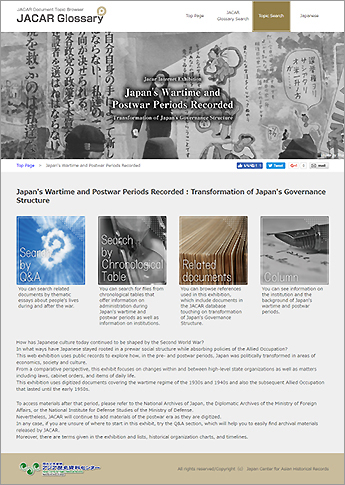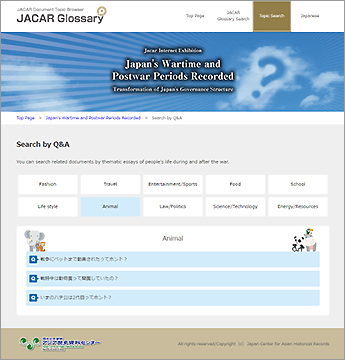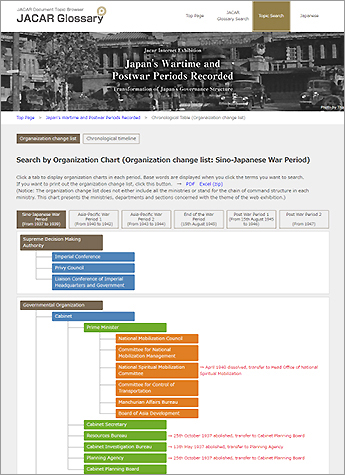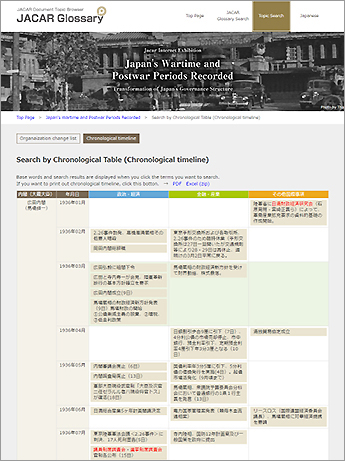

2. Information on Newly Released Documents
-Documents released on December 7, 2016 / Documents released on January 17, 2017
/ Documents released on January 19, 2017
-Documents released on January 31, 2017 / Documents released on February 1, 2017
3. Introduction of New Contents : A special web exhibition
"Japan's Wartime and Postwar Periods Recorded : Transformation of Japan's Governance Structure"
4. Outreach Activities
-Publicity Work / Visitors
5. Information on Related Document Holdings
The Condition of Japan Related Materials in Japan
-Institute for Research in Humanities, Kyoto University / The Maizuru Repatriation Memorial Museum
/ The Kyoto Prefectural Library and Archives
The Condition of Japan Related Materials in Europe
-The National Archives of Romania
-Freie Universität of Berlin Campus Library / Political Archive of Federal Foreign Office
/ Berlin State Library
6. Donated Books List
7. Event Informations on the Related Organs
-National Archives of Japan / Diplomatic Archives of the Ministry of Foreign Affairs
Japanese Immigrants in Seattle
In the pacific northwest of the United States, Seattle serves as the biggest city in Washington State. Immigrants have been indispensable to making Seattle what it is today and this article traces the history of Seattle through its Japanese immigrants, with related documents from JACAR's database.
- Associations of Japanese in Seattle
After Nippon Yusen (Japan Mail Shipping Line) started a direct shipping route between Yokohama and Seattle in 1896, a lot of Japanese laborers crossed the Pacific to Seattle. They settled in a district downtown and formed what is referred to as Japan Town. They also created an association for Japanese, and such associations for local communities of Japanese residents were common among immigrants to exchange information as well as to protect and expand their rights and benefits while promoting friendships with locals.
![[Image 1] The Panama Hotel, a symbol of Japan Town in Seattle (photo by the author on March 30, 2016)](img/022_content01_01_01.jpg)
[Image 1] The Panama Hotel, a symbol of Japan Town in Seattle (photo by the author on March 30, 2016)
The Japanese Association of North America was founded in Seattle in May 1900, according to the document "13. Seattle Chamber of Commerce" (Reference Code : B08061531000) (see [Image 2]). A few years later, in January 1908, the Japanese Business Club was created and later renamed in January 1928 to the Seattle Japanese Chamber of Commerce. Subsequently in 1931 the Japanese Association of North America and the Seattle Japanese Chamber of Commerce were merged into the Japanese Chamber of Commerce and Japanese Association of North America.
There is a different telling of this history in the research of Mitsuhiko Sakaguchi, who has suggested that efforts to establish the association for Japanese in Seattle had begun around February 1899. Sakaguchi alleges that the association’s rules and regulations were drafted in October 1899 for approval as an incorporated organization by the Washington State government the following year. Then in 1907 the association was reorganized as the Japanese Association of the State of Washington, but divided by another group which formed in 1910 as the Japanese Association of Seattle. These two organizations temporarily went on but were finally merged into the Japanese Association of North America in 1912.
So while there multiple retellings of the historical details discussed in the past few paragraphs, it can be said that the first association for Japanese immigrants formed in Seattle around 1899 or 1900, but was then repeatedly divided and reintegrated.
- The Anti-Japanese Movements and "the Anti-Japanese Land Law"
There were anti-Japanese movements in the United States which sought to exclude Japanese immigrants from daily life at the time the Japanese Association of North America was established in Seattle. While there was a growing sense of caution against Asia in Europe and in America from the mid-19th century, more and more Asians came over to the United States for work. Many American workers were inclined to exclude Asians because they feared their jobs would be replaced by cheap laborers. Campaigns mounted first at the end of the 19th century against Chinese immigrants, the biggest population of the Asian immigrants, resulting in a series of institutional measures to restrict Chinese immigration (* note 1). And then exclusion gradually shifted to targeting Japanese immigrants, particularly in California where a lot were settled along with Chinese. At this time, US federal laws did not allow for non-white Asian immigrants to be naturalized in America, although children could acquire citizenship if born within the country.
Treatment for Japanese in Seattle reflected trends occurring in neighboring California. In 1921 the Anti-Japanese Land Law was passed in Seattle, adopting another state's legislature, the California Alien Land Law of 1913. This state law prohibited aliens ineligible for citizenship to own or rent land more than three years. Although this act could be applied to Asian immigrants in general, it was presumed that the main target was the Japanese settlers, and it is widely known today as the Anti-Japanese Land Law (* note 2).
The social context of this law in the early 20th can be understood by reviewing the document titled, "2. Anti-Japanese Issues / 11. The Case against Violation of the Land Law of Washington State" (Reference Code : B13081487700) (see [Image 3]). It is based on explanatory material for the 49th session of the Imperial Diet in 1924. This document describes that Japanese farmers in Washington attempted to transfer the ownership of their land to Americans or citizen children in order not to have land confiscated in violation of the law. While some Japanese farmers were charged with violating the law by the Washington State prosecutors, some of the Japanese won trials because the court found the prosecution unreasonable.
![* Click to Enlarge [Image 3] Title: 2. Anti-Japanese Issues / 11. The Case against Violation of the Land Law of Washington State (1st-2nd images)](img/022_content01_03_01.jpg)
[Image 3] Title: 2. Anti-Japanese Issues / 11. The Case against Violation of the Land Law of Washington State (1st-2nd images)
- The Japanese Immigrants in Pike Place Market: 1926
Washington's Anti-Japanese Land Law influenced the livelihood of local Japanese merchants at Seattle's biggest municipal market, Pike Place Market. The document of "12. "Seattle" "Pike" Market" (Reference Code : B11092205500) (see [Image 4]) is a report about the market from the Japanese Consulate in Seattle to the Japanese Foreign Minister dated in June 19, 1926, five years after enactment of the state law.
According to this report, the number of the Japanese merchants was 82, more than half of the total number of 152 salespersons of farm products at Pike Place Market, and the Japanese had 7 booths among 12 or 13 booths at the Arcade, the most prosperous area of the market. However, the Japanese merchants had to face growing antipathy of merchants from other countries, which prompted exclusion of Japanese flower shops from the market in 1922. And in the middle of April 1926, the market's second biggest group, 60 Italian merchants, submitted a petition to the Seattle City Council that the city should kick out all the Japanese merchants so they could acquire their share. This report says that the Japanese merchants stayed optimistic because Seattle's City Council and the market's management company Goodwin were strongly opposed to the petition and wished to keep the status quo.
However, this report also indicates that Japanese had some reason for caution, since this conflict concerned the Anti-Japanese Land Law. According to the market's regulations, only farmers who owned land in King Country, Seattle could open booths. Yet the report says that the Japanese farmers were not able to own land because of the Anti-Japanese Land Law.
- The Japanese Immigrants in Pike Place Market: 1931
As the United States went through the Great Depression from 1929, Japanese merchants in Pike Place Market faced an increasingly dire situation, even more so than what was depicted previously in 1926 according to a November 10, 1931 report from the Japanese Consulate in Seattle to the Japanese Foreign Minister "6. Seattle" (Reference Code : B09040487400) (see [Image 5-1] and [Imagde 5-2]).
According to this report, the farmers sold their crops directly at rented booths, and the location and the schedule of the 98 booths in total were assigned by lot. Because of the Great Depression, roughly 249 farmers, merchants and delegates applied and scrambled for the limited number of booths. Some of those scrambling who were not Japanese sought to exclude Japanese farmers and merchants, a dominant group in the market. Campaigns were pushed forward that aimed to revise market regulations so that delegates would be ineligible to participate in the lot drawing. As a result, the regulations were revised on November 1 of 1931.
The report explains the impact of this policy on Japanese farmers, who were not entitled to own or rent land with their own names because of the Anti-Japanese Land Law. Thus their land was secured via proxy through American farmers and therefore in a legal sense they were not actual farmers with respective rights. The Japanese Consulate and the Japanese Association worked together to persuade business leaders of the Seattle Chamber of Commerce and secretaries of the mayor to suspend implementation of the new regulations. But the following report that we will examine casts doubt about the fragile status of the interests of Japanese farmers. It concerns the booths assigned by lot among delegates and also the possible recurrence of anti-Japanese movements.
- The 'Future' of the Japanese immigrants in Seattle
How did Japanese immigrants think about their future in America during strong anti-Japanese movements? The document "25. About the Upgrade of the Consulate in Seattle" (Reference Code : B14090319300) (see [Image 6]) is a petition to upgrade the Japanese Consulate in Seattle as submitted to Japanese Foreign Minister Kijuro Shidehara by Kojiro Takeuchi, the president of the Northwest American Japanese Association (* note 3).
President Takeuchi wrote that there were about 20,000 Japanese immigrants under the jurisdiction of the Consulate in Seattle. Although no new immigrants came from Japan, the number of Japanese increased due to the second generation born in America (* note 4).
On this point, Takeuchi wrote "the future prospect of Japanese residents will be gradually more promising." Takeuchi emphasized the importance of friendship between the United States and Japan. He argued that the first priority should be expansion of the US-Japan trade and lives of the immigrants would be connected to trade expansion.
However, Takeuchi's positive vision for US-Japan friendship did not quickly materialize. After the outbreak of the war between the United States and Japan in December 1941, the US government began to forcefully relocate and intern Japanese immigrants, which marked the hardest period for Japanese immigrants in America. The US government maintained a legal framework to define Japanese immigrants as "enemy aliens" until 1949. Since then, because the United States gradually established and reformed legal measures about ownership of land and acceptance of new immigrants, Japanese-Americans paved the way for a new era in the American society.
![[Image 7-1] Pike Place Market of the present day (photo by the author on April 3, 2016)](img/022_content01_07_01.jpg)
[Image 7-1] Pike Place Market of the present day
(photo by the author on April 3, 2016)
![[Image 7-2] Pike Place Market of the present day (photo by the author on April 3, 2016)](img/022_content01_07_02.jpg)
[Image 7-2] Pike Place Market of the present day
(photo by the author on April 3, 2016)
[note 1] In 1882, the Chinese Exclusion Act prohibited Chinese laborers (except merchants and some others) from entry into the United States. Initially this was a temporary measure for ten years, but subsequent legislation maintained the prohibition for a long time. [↑]
[note 2] Prof. Toshihiro Minohara defines this law as a key step for the anti-Japanese movements in California and examines the historical process of this law in detail in his book, The Anti-Japanese Movement and the US-Japanese Relations: Why "the Immigration Act of 1924" Was Enacted? (2016). He presents important findings that the Japanese immigrants rather expanded their own land by using loopholes of this state law after its enforcement. However, a new land law was passed as a more strict measure in 1920 (called as "the Second Anti-Japanese Land Law") when the anti-Japanese movements expanded across the country. [↑]
[note 3] The Northwest American Japanese Association headquartered in Seattle, consisted of delegates of Japanese associations in fifteen cities under the jurisdiction of the Japanese Consulate in Seattle including fourteen cities in the State of Washington such as Seattle, Tacoma, Bellevue and Yakima. Havre in the State of Montana was also included under the jurisdiction. Similar organizations coordinating regional Japanese associations were established in the areas of the Japanese diplomatic missions: New York, Chicago, Los Angeles, San Francisco, Portland, Seattle and Vancouver in North America and Canada (see Beikoku seihokubu zairyu nihonjin hatten ryakushi [The Brief History of Japanese Settlers in Northwest America], 1921). [↑]
[note 4] Immigration from Japan into the United States was limited by the Gentlemen's Agreement of 1907 between those two governments, and then, was strictly prohibited by the Immigration Act of 1924. However, it should be noted that despite the name of the Japanese Exclusion Act, it excluded not only Japanese. [↑]
[References]
Beikoku seihokubu renraku nihonjin kai [The Northwest American Japanese Association], ed., Beikoku seihokubu zairyu nihonjin hatten ryakushi [The Brief History of Japanese Settlers in Northwest America] (Seattle: Beikoku seihokubu renraku nihonjin kai [The Northwest American Japanese Association], 1921).
Funakoshi, Ryosuke, "Seattle nihon kokugo gakkou hatsu no shoto riyo nihongo kyokasho ni kansuru ichikosatsu" [A Study on the First Japanese Textbook Used in Elementary Class of the Japanese Language School in Seattle], Gakko kyoikugauku kenkyu ronshu [Journal of Educational Research], No. 32 (2015).
Hirobe, Izumi, Jinshu senso toiu guuwa: ouka ron to ajia shugi [Fables of Ethnic Warfare: Yellow Peril and Pan-Asianism] (Nagoya: The University of Nagoya Press, 2017).
Kachi, Teruko, "Nichibei tsusho kokai joyaku to California-shu tochi hou" [The Japan-US Treaty of Commerce and Navigation and the California Land Law, Kokusai seiji [International Relations], Vol. 17 (1961).
Kessler, J. B., and Kan, Ori, "Nichibei kankei no image to beikoku renpou seido: kashu hainichi tochiho ronso wo tsujite no ichikosatu" [Images in Japan-U.S. Relations as Affected by the Dynamics of American Federalism: Studies on Japan-U.S. Relations with Special Reference to Mutual Images], Kokusai seiji [International Relations], Vol. 34 (1967).
Kido, Yoshiyuki, America gasshukoku to chugokujin imin: rekishi no naka no "imin kokka" America [Chinese Immigrants in the United States: The Making of a "Nation of Immigrants"] (Nagoya: The University of Nagoya Press, 2012).
Kobayashi, Tohru, "Nikkei America jin shoshi" [Short History of Japanese American], Nagasaki kokusai daigaku ronso [Nagasaki International University Review], Vol. 2 (2002).
Kurokawa, Katsutoshi, Ryo-taisenkan no America seihokubu nikkei shakai: Seattle to sono shuhen chiiki ni okeru rodo, seikatsu, shimin undo [The Japanese Society in Northwestern America in the Interwar Period: The Movement for Labor, Life and Citizenship in Seattle and Its Neighboring Area] (Okayama: Daigaku Kyoiku Shuppan [University Education Press], 2011).
Kurokawa, Katsutoshi, "Seattle saisho-ki no nikkei shimin undo" [The Japanese American Citizens' Movement in Seattle, 1921-1928], Okayama daigaku keizaigakkai zasshi [Okayama Economic Review], Vol. 42, No. 2 (2010).
Kurokawa, Katsutoshi, America rodo undo to nihonjin imin: Seattle ni okeru haiseki to rentai [The Labor Movement in America and the Japanese Immigrants: Exclusion and Solidarity in Seattle] (Okayama: Daigaku Kyoiku Shuppan [University Education Press], 1998).
Minohara, Toshihiro, America no hainichi undo to nichibei kankei: "Hainichi imin hou" wa naze seiritsu shitaka [The Anti-Japanese Movements and Japan-US Relations: How "the Anti-Japanese Immigration Act" Was Passed] (Tokyo: Asahi Shimbun Shuppan, 2016).
Minohara, Toshihiro, Hainichi imin hou to nichibei kankei: "Hanihara shokan" no shinso to sono "judai naru kekka" [The Anti-Japanese Immigration Act and Japan-US Relations: The Truth about "the Hanihara Letter" and Its "Grave Consequence"] (Tokyo: Iwanami Shoten, 2002).
Mizutani, Kenichi, "1942 nen iminhou ni okeru "nihonjin mondai"" ["Japanese Problems" Associated with the U.S. Immigration Act of 1924], Doshisha America kenkyu [Doshisha American Studies], Vol. 33 (1997).
Sakaguchi, Mitsuhiro, "Nihonjin kai network: hokubei nihonjin kai no soshiki to katsudo wo chushin ni" [Japanese Association of North America and Network Relations], Shiso [Kyoto Women's University Journal of Historical Studies], Vol. 58 (2001).
Sugiura, Tadashi, "Ethnic town no seisei hatten model to beikoku nihonjin gai ni okeru kensho" [A Model of Ethnic Town Formation and Development Applied to Four Japantowns, or Concentrated Japanese Ethnic Business Communities, in America], Kikan chirigaku [Quarterly Journal of Geography], Vol. 63, No. 3 (2011).
|
National Archives of Japan
|
||||
|
Ministry of Commerce and Industries
|
Economic Stabilization Board
|
-
|
-
|
-
|
|
|
Economic Planning Agency
|
-
|
-
|
-
|
|
|
Ministry of International Trade and Industry
|
-
|
-
|
-
|
|
Records concerning the Economic Stablization Board are materials which were stocked at the Library of the Economic Planning Agency.
Records about the Economic Planning Agency consist mainly of files of official directives issued by the Economic Stability Headquarters and the Economic Deliberation Agency, as well as these organizations'subject registers and general affairs files.
Records of the Ministry of International Trade and Industry mainly include documents related to the enactment, amendment or abolition of laws and ordinances (documents requesting discussion by Cabinet meetings, etc.) and those related to the enactment, amendment, abolition, or public announcement of various regulations.
Also included are documents related to petitions, permission and approval.
|
||||
|
Diplomatic Archives of the Ministry of Foreign Affairs
|
||||
|
Records of the Ministry of Foreign Affairs
|
Series 6: Personnel Affairs
|
Category 1: Government Organization and Posts
|
Section 3: Foreign Government Organization and Foreign Diplomatic Establishments
|
-
|
|
|
|
|
Section 5: Appointment and Dismissal, Rewards and Punishments, and Pension, etc.
|
-
|
|
|
|
|
Section 6: Business and Round Trip
|
-
|
|
|
|
|
Section 7: Examinations and Officials Studying Abroad
|
-
|
|
|
|
|
Section 8: Officers of Embassies, Legations and Consulates of Foreign Countries
|
-
|
|
The Records of the Ministry of Foreign Affairs "Series 6: Personnel Affairs" is comprised of Meiji and Taisho era documents concerning Ministry of Foreign Affairs personnel affairs.
The latter half of "Category 1: Government Organization and Posts" consists of documents concerning government organization and relevant matters, and it is now available.
Newly released "Section 3: Foreign Government Organization and Foreign Diplomatic Establishments" consists of documents on issues such as establishment of diplomatic missions of foreign countries and interests sections of foreign governments in Japan.
"Section 5: Appointment and Dismissal, Rewards and Punishments, and Pension, etc." includes files of appointment and dismissal of Japanese ambassadors, ministers, foreign service officers and military attaches of the Japanese diplomatic missions overseas.
"Section 6: Business and Round Trip" contains records of overseas business trips of the Japanese officials and military officers and reports of the Japanese diplomatic missions overseas.
"Section 7: Examinations and Officials Studying Abroad" has documents relating to travel expenses, academic records, and applications for return home presented by the Japanese officials studying abroad.
Finally, "Section 8: Officers of Embassies, Legations and Consulates of Foreign Countries" includes papers of appointment and dismissal of officials of foreign service posts in Japan.
|
||||
|
The National Institute for Defense Studies, Ministry of Defense
|
||||
|
Army Records (Rid of Dainikki)
|
Chuo (General)
|
Syusen Syori (End-of-War Settlement)
|
-
|
-
|
|
This series consists of records related to the transfer of weapons kept by the Japanese Army as well as records of Japanese soldiers being demobilized outside of Japan.
The newly released records in this series include materials about sanitation of the Southern Army and the 7th Area Army and overviews of the Communist-controlled territories in China.
|
||||
|
The National Institute for Defense Studies, Ministry of Defense
|
||||
|
Army Records (Rid of Dainikki)
|
Rikuku (Army Air Forces)
|
Nanpo-Shinko (Southern Attack)
|
-
|
-
|
|
This series of army records includes reports of the air operations in the Southern and Southeastern areas such as Java, Sumatra, Burma, Singapore and Malaya.
It was produced and compiled mainly by the 1st Demobilization Bureau, the Southern Army Headquarters and the 3rd Air Division.
|
||||
|
The National Institute for Defense Studies, Ministry of Defense
|
||||
|
Army Records (Rid of Dainikki)
|
Rikuku (Army Air Forces)
|
Philippines (Decisive War)
|
-
|
-
|
|
This series of records about the army includes records of air operations and a list of units in the Philippines compiled by the 1st Demobilization Bureau after the war; files of documents about the command of Operation Sho in the Philippines produced by the 4th Air Army during the war; materials about repatriates, combat diaries of airfield battalions, and maps and pictures of airfields in the Philippines.
|
||||
|
The National Institute for Defense Studies, Ministry of Defense
|
||||
|
Army Records (Rid of Dainikki)
|
Rikuku (Army Air Forces)
|
Sina-Houmen (China Region)
|
-
|
-
|
|
This series of records of the army includes records of air operations and airfields in China compiled by the 1st Demobilization Bureau after the war; documents of the 4th Air Brigade and files of 10-day wartime reports during the Sino-Japanese War; detailed activity reports of the 15th Air Signal Unit; combat diaries of the 56th Airfield Battalion; detailed activity reports of the 15th Field Army Aviation Supply Depot; and detailed battle reports of the 4th Independent Air Company.
|
||||
|
The National Institute for Defense Studies, Ministry of Defense
|
||||
|
Army Records (Rid of Dainikki)
|
Rikuku (Army Air Forces)
|
3FA
|
-
|
-
|
|
This series of records includes items on the formation, air operations, deployment, intelligence and wartime monthly reports of the 3rd Air Army (called as Air Command Tsukasa: 3FA) in the Southwestern area; documents of the air operations of the 5th Air Division in Burma; files of operation orders of the 9th Air Division; detailed battle reports and combat diaries of the 4th Field Airfield Construction Unit.
|
||||
|
The National Institute for Defense Studies, Ministry of Defense
|
||||
|
Army Records (Rid of Dainikki)
|
Rikuku (Army Air Forces)
|
Manshu-Houmen (Manchuria Region)
|
-
|
-
|
|
This series of records about the air operations of the former Japanese army includes records of operations of the Kanto-Gun (Kwantung) Army Air Force; detailed activity reports of the 10th Air Battalion; detailed battle reports of the 8th Independent Air Company; combat diaries of the 2nd Nomonhan Incident of the 9th Air Sector Unit; and combat diaries of the 56th Airfield Battalion.
|
||||
|
The National Institute for Defense Studies, Ministry of Defense
|
||||
|
Navy Records (Rid of Koubunbiko)
|
3. Daitoasenso (Greater East Asia War/the Pacific War)
|
Zenpan (General)
|
-
|
-
|
|
This is a collection of operation records of navy vessels and landing combat units in the Pacific War.
It includes the political and military strategies to the outbreak of the war (1931-1939); overviews of the situations in the Pacific War; materials for assessments of the situations provided by the 1st Department of the Naval General Staff Office; statements released by the Imperial Headquarters; the naval history of the Greater East Asia War; and a brief history of WWII.
|
||||
|
The National Institute for Defense Studies, Ministry of Defense
|
||||
|
Navy Records (Rid of Koubunbiko)
|
3. Daitoasenso (Greater East Asia War/the Pacific War)
|
Soren (Soviet Union)
|
-
|
-
|
|
This is a collection of records of navy vessels and landing combat units, particularly for operations on the Soviet Union, in the Pacific War.
It includes records of assessment of war capabilities of the military units in the Eastern region of Russia; reference materials about the issue of the Russian vessels; and the list of the concentration camps in Russia.
|
||||
|
The Institute for Economic and Business Research, Shiga University
|
||||
|
The Collection Relating to the Former Japanese Colonies
|
-
|
-
|
-
|
-
|
|
This is the collection of materials written in Japanese about the Japanese colonies and sphere of interest (Manchuria, Mongolia, China, Korea, Taiwan and South Seas) collected by the Investigation Department of Hikone Higher Commercial School (1923-1944), predecessor of the Institute for Economic and Business Research, Shiga University.
The major records are materials of investigation and research published by the colonial authorities (State Council of Manchukuo, Korea-Governor's General Office, Taiwan-Governor's General Office, and Territorial Government of South Seas Islands), various collections of photos, maps, guides and pamphlets, etc.
|
||||
|
Hokkaido Prefectural Library
|
||||
|
The Collection of Hokuetsu Shokuminsha
|
-
|
-
|
-
|
-
|
|
This is the collection of records of the Company Hokuetsu Shokuminsha (1886-1948) which was established by peasants from Echigo (Niigata) who migrated to Ebetsu-buto.
The main records are journals of Sekiya Magozaemon (one of the leading members of the company), various documents of the company, ledger, daily records, and drawing sheets, etc.
|
||||
Special web exhibition "Japan's Wartime and Postwar Periods Recorded : Transformation of Japan's Governance Structure"
How has Japanese culture today continued to be shaped by the Second World War? In what ways have Japanese stayed rooted in a prewar social structure while absorbing policies of the Allied Occupation? This web exhibition uses public records to explore how, in the pre- and postwar periods, Japan was politically transformed in areas of economics, society and culture.
-Domestic
|
February 7, 2017
|
Held presentation at "the Meeting of the Institutions of Asian Materials and Information" hosted by the Kansai-kan of the National Diet Library
|
|
February 22, 2017
|
Held presentation at the 2nd Training Session for Archivists of 2016, "About Construction of Digital Archives," (in the Hall of Nagasaki Museum of History and Culture) as part of the project of promotion for attractions to explore and connect "the History of Nagasaki"
|
|
December 2, 2016
|
Prof. Xun Pan and lecturer Yuxiang Yang of Southwest University (China), Prof. Yong Xu of Beijing University, and 3 other researchers
|
|
December 8, 2016
|
Prof. Bin Zhang and Prof. Jian Wang of School of Information Resource Management, Renmin University of China, and Ziqing Rong, curator and database engineer of the Tokyo Gakugei University Archives
|
|
February 1, 2017
|
Yasuyo Otsuka, Japanese Section, Asian and African Studies, The British Library
|
The Condition of Japan Related Materials in Japan
JACAR Researcher Muneaki Hirano and Daisuke Hayashi visited the following three institutions to learn about their collections and digitization projects during a trip to Kyoto June 2016. Below is a report of the visits.
The Institute for Research in Humanities was originally established as the Kyoto Institute of the Academy of Oriental Culture, launched by the Oriental Cultural Programs in 1929. The academy had two institutes, one in Tokyo and the other in Kyoto, both founded through subsidies from the Ministry of Foreign Affairs. The Kyoto Institute was renamed the Institute of Oriental Studies in 1938 and set up as the Institute for Research in Humanities in Kyoto Imperial University the following year. In the postwar period, the Institute for Research in Humanities was reorganized by merging the Institute of Humanistic Studies, the Institute of Occidental Studies (former Deutsches Forschungsinstitut (German Cultural Institute) and the Institute of Oriental Studies. Initially it consisted of the Japanese, Oriental and Occidental branches.
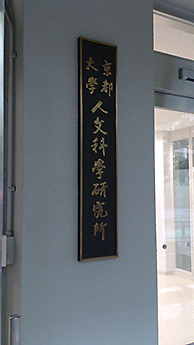
The entrance of the Institute for Research in Humanities, Kyoto University
And as a result of changes in the year 2000, now it includes the following affiliated research centers, the Department of Humanities (3 divisions: Cultural Research Methodologies, Cultural Processes, and Cultural Interrelationships), the Department of Oriental Studies (2 divisions: Cultural Representation and Cultural Composition Division), the Center for Informatics in East Asian Studies (CIEAS) and the Research Center for Modern and Contemporary China (RCMCC: jointly established by Kyoto University and the National Institutes for the Humanities, which is part of the Inter-University Research Institute Corporation).
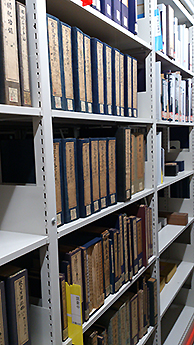
The "Naito Collections" in the stack room
Kyoto University's holdings in the Institute for Research in Humanities consist of books and materials originally of the former Oriental, Japanese, and Occidental branches as well as of items purchased at the institute for research projects. The collections of the former Japanese branch include materials of political history, social movement history, legal system and cases, and newspapers and periodicals of prewar proletarian parties, labor unions, farmers' associations, the National Levelers' Association (Suiheisha), and cultural movement organizations. The holdings of the former Oriental branch consist of the Chinese classic materials during the period of the Institute of Oriental Studies, and materials from the medieval to the modern era, and local history, and newspapers during the period of the Republic of China and the People's Republic of China. Those also include the "Naito Collections" of books mainly about Manchuria and Mongolia collected by the late Dr. Torajiro "Konan" Naito, professor emeritus of Kyoto University.
The collections of the former Occidental branch mainly include French books and materials of the 18th and the 19th centuries which consist of the "Saint-Simon and Fourier Collections." And as other categories, the Institute also has the collections of "Materials" including goods, books, references and pictures purchased and donated since the foundation of the Institute.
The entire collection of the Institute for Research in Humanities has been growing by purchases and donations of materials, but the institute currently does not accept donations in principle. Among the collections, the materials about labor unions and the National Levelers' Association (Suiheisha) of the former Japanese branch are not original documents but copied or microfilmed materials. And as the "Naito Collections" of the former Oriental branch are basically commercial books and materials collected by Dr. Torajiro "Konan" Naito, the collections do not have essential values as historical materials and are not frequently requested by users, except for the Manchuria-related materials such as the "Official Gazette of the Manchukuo Government" and the "Mukden Economic Quarterly."
CIEAS in the Institute for Research in Humanities stores a large volume of pictures from during the war. Among those images, CIEAS does not disclose the index of materials which have clear enough images of individuals who can be identified or contents that are difficult to be handled. CIEAS holds film recording the expedition to the Yungang Grottoes by the Institute of Oriental Studies in 1938 and has released the film as digitized materials on the Research Resource Archive of the Kyoto University Digital Archives System (KUDAS). KUDAS is a platform to release research and completed projects, sometimes by retired Kyoto University scholars. It operates by converting the contents of materials into a certain format, editing the data, and uploading the files as public contents on the platform.
While CIEAS contains a multifaceted database, it has no specific division in charge of digitization. Staff members of CIEAS undertake the process of digitization and building online infrastructure for its research projects. One of the leading staff members for digitization and the online system construction is Dr. Koichi Yasuoka, professor of the Institute and coordinator of CIEAS. Prof. Yasuoka has joined several collaborative research projects, learning about them and helping to disseminate their findings by setting up online infrastructure. He generally uses JPEG or TIFF formats for digitization of images, and also adopts DjVu format for digitization of maps or for embedding texts in images (embedding text information in each letter on image files).
"The Stone Rubbing Character/Word (Takuhon) Database of the Institute for Research in Humanities, Kyoto University" is the digital collections of stone rubbing characters (takuhon) from the ancient Han dynasty to the modern Republic of China period. This database presents digital images of rubbings not only in JPEG format but also in DjVu format for advanced functions. Those functions include displaying the letter of each character image on digital files and also calling different patterns of images of the same letter on other files in the database. Prof. Yasuoka designed those advanced functions by himself for embedding letters in each character on image files and calling different patterns of images by using DjVu interfaces (this database was created by the collaborative research project in which he served as a coordinator).
Prof. Yasuoka has been constructing an online system of research principally in HTML for easy maintenance in the long term. Some of the research projects are shared online and linked to others within their search results and detailed index. It is possible to share and commonly use those resources via meta data in CSV format from each collaborative research unit which is in charge of meta data contents (and the meta data may be modified upon a request of the collaborative research unit). The financial resources for digitization or making database of those collaborative research came from the Grants-in-Aid for Scientific Research (Kakenhi) funded by the Japan Society for the Promotion of Science, although it is mainly financed today from the budget of the Institute itself as a collaborative research center. While digital contents are basically open to the public and can be used freely for secondary use, the institute requests users to cite sources of the digital contents for publication of books and articles. Particularly, "the Stone Rubbing Character/Word (Takuhon) Database" and the map database are most frequently accessed for secondary use. The Takuhon Database, essentially designed for scholars of Chinese area studies, is also frequently used among calligraphers in order to search for a various kind of styles of letters. It was totally unexpected, reported Prof. Yasuoka, that it would be used in that way but it caused different types of demands for potential users.
Prof. Yasuoka emphasized that it is quite important that digitized materials should be maintained and research institutes should bear responsibility for managing the contents and responding to various kinds of inquiries to the materials.
The Maizuru Repatriation Memorial Museum, in Maizuru, Kyoto, is an institute for holding and exhibiting collections of materials about demobilization and repatriation of people from Manchuria and the Korean peninsula as well as Japanese interned and returned from Siberia. Maizuru was one of the designated ports for repatriation in the postwar period, particularly for those interned in Siberia. The museum was planned in commemoration of the 40th anniversary of the end of the war. And local people who were former repatriates from the Japanese overseas territories and those who welcomed those in Maizuru also wished for it. It was opened in 1988 and is now operated by Maizuru City after temporary management by a public-private partnership.
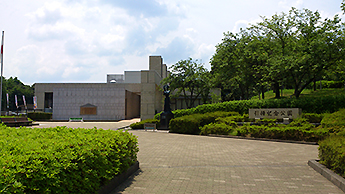
The Maizuru Repatriation Memorial Museum
(in the Repatriation Memorial Park)
In October 2015, a part of the museum's collections (570 items) were inscribed on the list of the UNESCO Memory of the World Register as the "Return to Maizuru Port—Documents Related to the Internment and Repatriation Experiences of Japanese (1945-1956)."
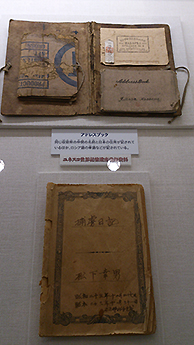
The exhibits (Items inscribed on the list of the UNESCO Memory of the World Register)
The entire collections of about 16,000 items include various kinds of daily commodities of former repatriates, certificates and documents about repatriation, diaries and letters written during their internment, and approximately 1,300 drawings and paintings of their own experiences of internment (including illustrations by famous cartoonists). The Museum also has approximately 3,000 books about demobilization and repatriation. Most of the materials were donated from people throughout Japan.
And many of those donations are items presented by the owner (former repatriate) or the bereaved family as they wish those items would be inherited in the future. The collections have been growing as the museum receives donations from roughly thirty people each year, and particularly as many as ninety offers in 2015, when some of the museum collections were inscribed into the UNESCO Memory of the World Register. Although the Museum has accepted many types of donations so far, it will select rare and valuable items concerning repatriation and internment in Siberia, since the Museum repositories are limited in its capacity.
The items in the museum's holdings have been digitized and can be searched and displayed by thumbnail images from terminals in the exhibition rooms. Some items are also displayed as digital images in the gallery collections on the museum's official website. The museum has edited these images by masking personal information on image files in the digitization process.
The museum does not accept requests for specific materials out of personal interest, although it has accepted a large number of applications for secondary use of materials. Yet it does not open the boarding lists of repatriates on demobilization ships to the public because they include a lot of personal information. Some of the materials that include personal information can be accessed if the donors or the persons concerned provide permission for release. Unless the museum has obtained approval for the release of personal items, they will not be open to the public or will be edited with masking when accessed from terminals in the exhibition room.
The number of visitors has been increasing from less than 70,000 in 2012 to 130,000 in 2015 because the museum has been working on public relations by offering lectures at neighboring schools, inviting groups on tour via travel agents, offering quick responses to inquiries from local newspapers and the mass media, and the museum has also been appealing to tourists on school trips (particularly in the Kanto or the Tokai area to Kyoto). Recently there has been an uptick among visitors aged in their 20s to 50s, although the majority of visitors are aged over 60 and had directly experienced, or knew of those who had undergone, repatriation and internment in Siberia.
Since the museum was reopened after renovation in September 2015, it has limited the number of items for exhibitions and selected about 800 out of 1,500 items of the former permanent exhibitions. And it displays transcripts of exhibited items so that the visitors can easily learn the materials, and provides about 1,000 books available at the library corner. Those items are displayed with multilingual descriptions in Japanese, English, Chinese and Russian. The museum has been improving its exhibitions with a wide variety of visitors in mind, from elementary school kids to older folks and even foreign visitors. The improvements are being made so that many can learn the exhibitions through texts, quizzes and references.
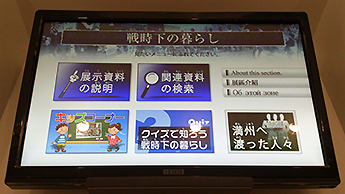
A touchscreen display in the exhibition room
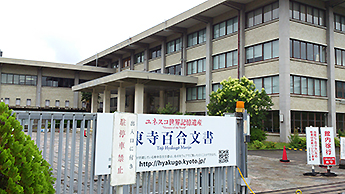
The Kyoto Prefectural Library and Archives
(photo by the auther on June 28, 2016)
The Kyoto Prefectural Library and Archives in Sakyo-ku, Kyoto, was initially established in 1963 to serve as a combined institutional folklore museum, archives, and library (part of holdings of the Kyoto Prefectural Library). After a series of reorganizations of detaching part of the museum division (to The Museum of Kyoto) and the archives division (to the Kyoto Prefectural Museum) from it and restructuring the library division, the Library and Archives served as a multi-purpose organization to hold books and archives (specifically about Kyoto), public papers (of the Kyoto Prefectural Government, particularly Governor's Office), pictorial materials and modern literary works until September 14, 2016.
The Kyoto Prefectural Library and Archives also commissioned management of items of fine arts, crafts and folklore to the Kyoto Cultural Foundation. One of the major collections, "the Toji Hyakugo Monjo" [archives of Toji temple contained in one-hundred boxes], was inscribed on the List of the UNESCO Memory of the World Register in October 2015. The entire collections of the Kyoto Prefectural Library and Archives include approximately 380,000 books, 130,000 archival items, 90,000 public records, 70,000 pictorial materials and 20,000 modern literary works.
The old Kyoto Prefectural Library and Archives was closed for demolition bus still standing until September 14, 2016, and the new building Kyoto Institute, Library and Archives was partially opened on December 23, 2016. It will be fully operational this year. The Kyoto Institute, Library and Archives will be located on the campus of the Kyoto Prefectural University and used as part of research facilities for the Faculty of Letters and the library of the university. With those new initiatives, the institute will "offer research aid for history and culture of Kyoto and opportunities for learning and exchange, and serve as a new cultural and learning exchange base in Kitayama, Kyoto." The following report is based on the information of the old Kyoto Prefectural Library and Archives at the moment of our visit in June 2016.
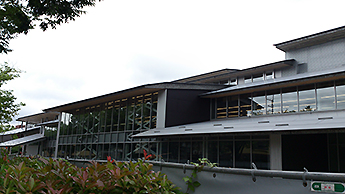
The Kyoto Institute, Library and Archives
under construction
(photo by the auther on June 28, 2016)
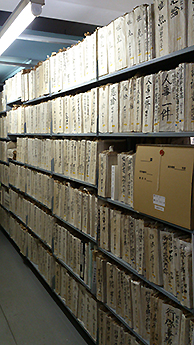
The public records in the stack room
Among the public records held in The Kyoto Prefectural Library and Archives is "the Kyoto Prefectural Government Papers", which have been created or accepted since the establishment of the Kyoto Prefectural Government in 1868 until the present day by the Governor's Office and designated for permanent preservation as records. The papers are transferred to the Kyoto Prefectural Library and Archives 25 years after their original production, and there are about 1,500-2,000 new files transferred each year. "The Kyoto Prefectural Government Records" are public records which had been created as references by the Kyoto Prefectural Government from the Meiji era up to the Second World War. These records are not designated for permanent preservation. Such documents form the major collections of the public records in The Kyoto Prefectural Library and Archives.
The organization has also occasionally accepted donations of materials, particularly administrative documents of the prewar days that were donated by some citizens. The staff also review primary records without a prior designation for permanent preservation periodically (5, 10 or 20 years) before disposing of documents or selecting some of them to be transferred for long term access in the Kyoto Prefectural Library and Archives. These total about 100 files a year and are sent after consultations with the departments or sections that originally created those records. The records are selected for archiving based on whether they can supplement the permanent preservation records or hold much social interest (e.g. human rights or environmental content, etc.).
The Kyoto Prefectural Library and Archives has not actively promoted digitization of files so far, because it has had no specific budgetary items for it. However, along with restoration of the important cultural properties that date prior to 1946 as funded by the Agency of Cultural Affairs, the Kyoto Prefectural Library and Archives also outsources digitization of properties for future release as the digitized materials. It is currently preparing for digitization with a budget of 100 million yen from 2014 to 2016 since digitization is one important objective for opening the new building. It prioritizes digitization of items from the Meiji period which are easy for capturing, as they remain generally in good condition and they are on specific topics such as disasters (particularly floods) or municipal mergers. The Kyoto Prefectural Library and Archives registers digitized materials and currently releases only its index at the Kyoto Memories Archive, which is a digital archives maintained by the Kyoto Prefectural Library and Archives. The Kyoto Memories Archive, which was launched in November 2015, also offers digital images and some major collections to the public. It is working to integrate its archival systems and combine them, so the Kyoto Kitayama Archives and the Kyoto Memories Library, which are currently closed, will be available online through the Kyoto Memories Archive.
→The Kyoto Prefectural Library and Archives, The Kyoto Memories Archive (Japanese only)
The majority of visitors to these archives are scholars interested in the Lake Biwa Canal or the railways, amateur researchers, undergraduate and graduate students researching educational history, park history and building evacuations. Not so many visitors research family history, presumably because there are not genealogical records or residential maps before about 1955. The most frequently used materials are cadastral maps of the Meiji period (marking the boundaries of land ownership and topographies) and records of construction projects. These materials can be used for secondary use in principle after a due process of applications, payment for commissions, and permission for use issued by the Kyoto Prefectural Library and Archives. Users can freely access the digitized items of the Kyoto Memories Archive for secondary use without submitting applications.
The Condition of Japan Related Materials in Europe
JACAR Senior Specialist for Archival Affairs Katsumasa Maruo and researcher Takeshi Sakuma visited the following four institutions to learn about their collections of Japan-related materials and digitization projects during a trip to Rumania and Germany September 2016. Below is a report of the visits.
The National Archives of Romania was established as an institution in 1831 during the Romanian Principalities period. Historically, archives had been handled by the rulers' courts or by monasteries without any norms or governing rules. The archives hold records transferred from central government agencies (the Presidential Chancellery, Parliament and Ministries, civil records, personal and family records, economic, technical and institutional records, local administrative records.
The institution has one central service and 43 territorial structures, for each county, including the city of Bucharest, the capital of Romania. At a national level, there are around 650 employees out of which circa 500 are professional archivists.
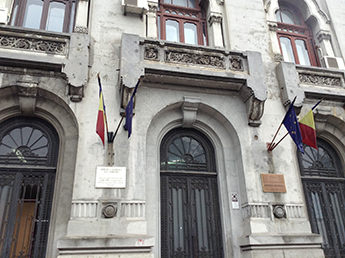
The facade of the National Archives of Romania
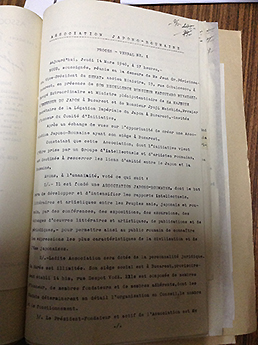
One of the documents of the Japan-Romania Cultural Association
The archives have around 50 repositories all across the country, 7 of them are located in Bucharest. The Service of National Central Historical Archives (SANIC) holds 5 of them, the most interesting of them areone repository of modern 19th and 20th century records including those of the communist government, and one repository of premodern records and classical works dating from the Middle Ages. The older repository includes Japanese literary works donated in the 18th century and Chinese documents of the 17th and the 18th centuries. There are also records from the past pertaining to Wallachia, Moldavia and Transylvania. In the modern repository, the communist regime. In collections pertaining to Japan there are records of a visit by Prince Takamatsu in 1931, documents of the Japan-Romania Cultural Association, reports of the birth of Prince Akihito to the King of Romania, credentials of Japanese ambassadors and ministers in Romania, and papers of the members of the communist party in Japan during the communist regime.
Documents pertaining to the communist era in Romania, arranged and managed by two staff members, can be accessed in a special reading room. Legal terms for free access, whendocuments are made available for public access, are between 75 and 100 years for all records, personal, respectively civil and national security documents. The National Archives of Romania have completed a program for the digitization of medieval charters, starting from the 15th century up to 18th. Papers of the Jewish community in Romania are also being digitized by the representatives of the community. The institution is involved in many cultural projects, and perioadicall opens its gates for organized visits, especially for young children and students in universities. The archives is actively working on its outreach through the Department of Publication Achievement and it directly organizes exhibitions, roundtable lectures and has a presence on Facebook.
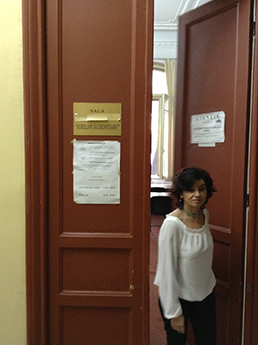
The reading room of the documents of the communist regime
- Freie Universität Berlin Campus Library (Campusbibliothek der Freie Universität Berlin) ( >> Website)
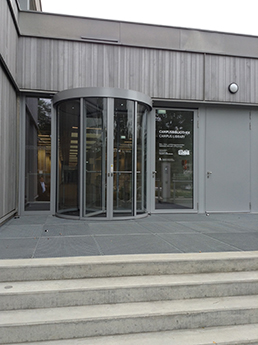
The entrance of the new Campus Library
Freie Universität Berlin was established in 1948 after World War Two by professors and students who fled to West Berlin from the Soviet sector's Friedrich-Wilhelms Universität zu Berlin (today: Humboldt-Universität zu Berlin). It holds an impressive reputation as one of the leading universities in Germany and was awarded the status of "University of Excellence" in the German federal and state "Excellence Initiative". It has twelve faculties and about 32,000 students, with an emphasis on research and education in the Humanities and Social Sciences. In the spring of 2015, a new "Campus Library" building was opened by merging 24 departmental libraries of 5 faculties as a new hub of research and education. It consists of two buildings (old library building and new library building), research offices, 2 classrooms and 950 reading/working desks.
The new library building has books of East Asian Studies, Middle Eastern Studies, Archaeology, Natural Sciences, and Mathematics while the old library building holds materials of Educational Science, Psychology and Religious Studies. The former is the fourth largest German university library of East Asian books following the libraries of the Faculty of East Asian Studies of Ruhr-Universität Bochum, Hamburg University and Heidelberg University. Among the entire holdings of approximately one million items, it has about 32,000 Japanese Studies, 19,000 Korean Studies and 42,000 Chinese Studies books and materials. Upon requests from the faculty members, it purchases books through the regular annual budget of each department/institute. The Korean Studies department receives additional generous funding by the Korea Foundation, National Library of Korea donation program "Window on Korea" (2015-2019); Supreme Court of Korea, Constitutional Court of Korea; National Assembly Library; Korean Film Council; Institute of Korean Classics; Literature Translation Institute of Korea (Hub Library Membership program).
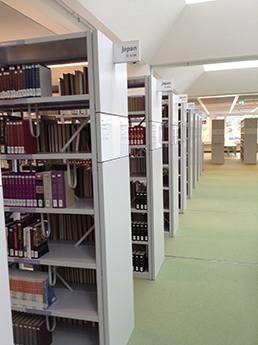
Japanese books in the stack room
All materials are held and arranged according to the specifications of RVK (Regensburger Verbundklassifikation consisting of 33 scientific classification schemes). Visitors can use the online catalogue "Library Portal Primo" (Bibliotheksportal Primo) to search the holdings with computers near the library's entrance. Visitors can also search for Asian-related materials, either digital or printed ones, with the Latin alphabet letters and in original script. Faculty members or students can request the digitization of materials out of copyright (published more than 70 years ago) free of charge at the imaging service of the University Library.
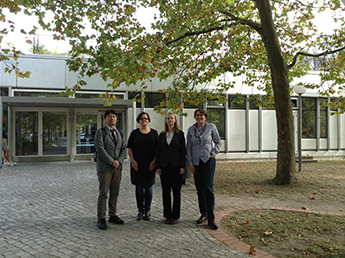
Expert in modern Japanese history Prof. Dr. Schmidtpott with librarians Dr. Wagner and Dr. Peucker
Furthermore, the library catalogue is connected to the KVK - Karlsruhe Virtual Catalog (Karlsruher Virtueller Katalog) for the search of holdings in other German libraries. Users can also ask for reference service including inter-library loans of books or photocopied journal articles via their personal user account. Among 25 librarians in the library, there is one permanent librarian and one temporary reference staff member who are in charge of Japanese Studies related materials and respond to inquiries even in Japanese.
→KVK - Karlsruhe Virtual Catalog
The library also has facilities of study rooms for students with infants, discussion rooms, and study carrels specifically for Ph.D. candidates where they can keep books and materials of the library for their dissertations for three months.
One of the precious materials of the Japanese collection is a handwritten memorandum by Tatsuo Amano, a defense lawyer of the League of Blood Incident and one of the nationalists who established the Patriotic Service Party, "the Summary of Defense (in the case against Akira Inoue and 13 other people of murders by the League of Blood)" (the provenance is unknown).
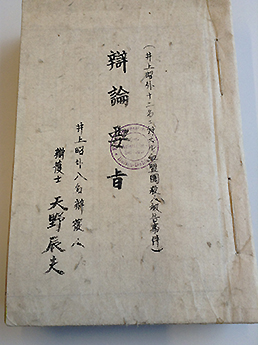
"Summary of Defense (in the case against Akira Inoue and 13 other people of murders by the League of Blood)"
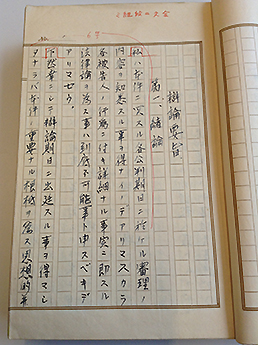
"Summary of Defense (in the case against Akira Inoue and 13 other people of murders by the League of Blood)"
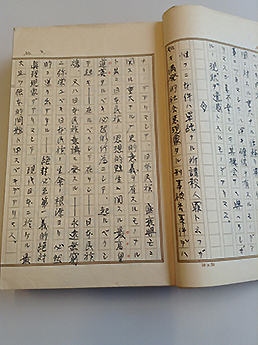
"Summary of Defense (in the case against Akira Inoue and 13 other people of murders by the League of Blood)"
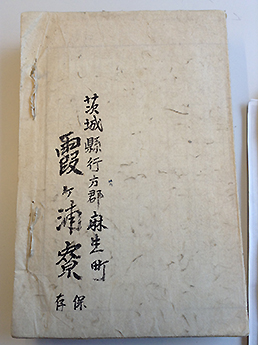
"Summary of Defense (in the case against Akira Inoue and 13 other people of murders by the League of Blood)"
The League of Blood Incident is a series of terrorist murder cases which took place in February and March 1932. Junnosuke Inoue (Finance Minister) and Takuma Dan (President of Mitsui Partnership) were assassinated by Sho Onuma and Goro Hishinuma each of who were under the tutelage of a nationalist leader Akira "Nissho" Inoue. Inoue and his group also planned to assassinate genro (senior advisory authorities) and other senior politicians of the government. As Onuma and Hishinuma had ties of kinship as cousins, the suspects called each other as a "soul mate of the League of Blood." In the background of the incidents, Japanese went through unprecedented recessions in the rural areas in Tohoku, labor unrest, suppression by authorities, corruptions and scandals of party politics. Incidents took place in the midst of growing pressure for state reforms and progressive movements promoted by nationalists and military officers.
The trials began on June 28, 1933 but were adjourned at their twelfth session due to petitions from the defendants to recuse chief judge Teiichiro Sakamaki and associate judges from the case. The trials started again with Goichiro Fujii newly assigned as chief judge on March 27, 1934, and the court was closed at the 64th session on August 23. After the prosecutors recommended a sentence on August 28, the judgment was made on November 22. The case was reported as a story of "the spirit of self-sacrifice" in the media, since individuals attempted to sacrifice themselves for an uprising that could sweep away corrupted power. It was regarded as a revolutionary attempt to receive so much sympathy from the public, and the defense lawyers received a lot of petitions for reduction of sentences written in blood or the black hair of women from all over the country. This memorandum is an irreplaceable material that describes Japan's modern history, along with "the Statement of Petition and the Prison Diaries of the League of Blood Incident" and "the Stenographic Records of the League of Blood Incident Trial."
Later, Tatsuo Amano was arrested on charges of preparations and plots of insurrection as leader of the Shimpei-tai Incident, a coup d'état to overthrow the government, and they planned and initiated for state reform movements after the failed attempt by the May 15 Incident of 1932.
[References]
"Ketsumeidan Jiken" [The League of Blood Incident] (written by Masae Takahashi), Kokushi daijiten [The Great Dictionary of National History], Vol. 5, Yoshikawa Kobunkan, 1985.
Makiyo Hori, "Ketsumeidan jiken no shinjuusha tachi: Onuma Sho, Hishinuma Goro, Yotsumoto Yoshitaka wo chushin ni" [The Followers of the League of Blood Incident: The Cases of Sho Onuma, Goro Hishinuma and Yoshitaka Yotsumoto], Waseda Daigaku Seiji Keizaigaku Zasshi [The Waseda Journal of Political Science and Economics], Vol. 329, 1997.
Ketsumeidan jiken kouhan kiroku kanko kai [The Publishers of the Stenographic Records of the League of Blood Incident Trial], Ketsumeidan jiken kouhan sokkiroku [The Stenographic Records of the League of Blood Incident Trial], Vol. 1-3, 1967-1968.
Ketsumeidan jiken kouhan kiroku kanko kai [The Publishers of the Stenographic Records of the League of Blood Incident Trial], Ketsumeidan jiken joshinsho gokuchu nikki [The Statement of Petition and the Prison Diaries of the League of Blood Incident], 1971.
- Political Archive of Federal Foreign Office (Politisches Archiv des Auswartiges Amts) ( >> Website)
The Political Archive was established in 1920 during the period of the Weimer Republic. It does not have its own independent building but is housed within the Federal Foreign Office of Germany. There are about 20 archivists although no specialists of Asia or Japan. Each archivist is required to answer inquiries of various kinds on topics including German foreign policy, so all the archivists are familiar with a wide range of issues. The archives hold a large volume of documents, including German relations with other countries and foreign policies. It also holds documents on treaties between Germany and other countries, reports on other countries from overseas establishments and more.
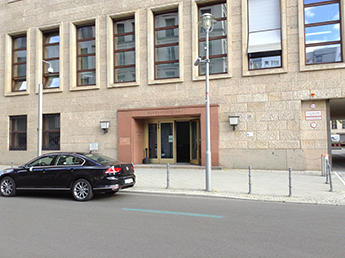
The facade of the Political Archive of Federal Foreign Office
The entire collection stretches to 27 linear kilometers in bookshelves; there are 36,000 files of treaties and conventions, for example. Although the Allied Powers had once seized some of the documents, the US and the UK returned most of them, aside from US files on the Nazi Party, between 1958 and 1960. Those documents were added to the Political Archive in the 1990s.
In collections pertaining to Japan, the archives has papers of Japan-German relations from the 19th century and papers on Japan-European relations. There are also files that examine developments between Japan and neighboring powers during the Sino-Japanese War of 1894 and the Russo-Japanese War of 1904, relations between Germany and its belligerents in wartimes, the Siberian Expedition, and reports on Japan and its neighboring countries from Germany's overseas establishments.
The archive has released all the documents which had been captured by and returned from the Allied Powers based upon agreements for release with those countries. It has also released other documents that had been thirty years old according to the Federal Archives Act. It has also released files with personal information ten years after the death of the person concerned.
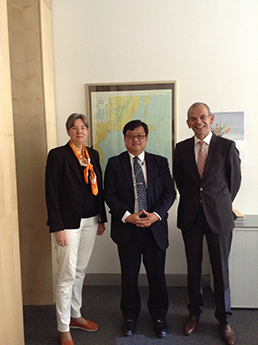
Dr. Keiper, Head of the Archive (right) and Dr. von Boeselager, reference officer (left)
The Archive digitizes documents. Those digitized files are not available on the internet but released based upon requests of researchers. Visitors can access those digitized images for their own purposes. Most of the visitors are German but some researchers in other European countries also access those documents on German-European relations. The archives sometimes exhibits diplomatic papers or works for joint projects for compilation of historical documents with other institutions, but does not actively court publicity. And while the archives does not have a permanent partnership with any foreign institution, it cooperates with overseas archives on projects and it holds exchange programs for archivists of other European institutions, and it has accepted archivists from Mongolia to exchange ideas.
In the German governmental system, it is not the federal government but each state that administers educational and cultural policies. The German National Library, therefore, consists of two buildings in Frankfurt/Main and in Leipzig (formerly the Deutsche Bücherei in East Germany and the Deutsche Bibliothek in West Germany) and the German Music Archive in Berlin. Apart from the National Library several other state libraries exist, such as the Bavarian State Library in Munich, and the Berlin State Library (Staatsbibliothek zu Berlin – PK, (http://staatsbibliothek-berlin.de/de/). The German National Library is a deposit libraries which receives all the publications in Germany and creates bibliographical records by law. The Berlin State Library was founded by the Great Elector, Friedrich Wilhelm von Brandenburg in 1661 and became the Prussian Royal Library in 1701. As the library building of 1913 was located in Unter den Linden within the territory of East Berlin after the Second World War, another building was constructed in West Berlin in 1978. After the German reunification of 1990, both the libraries were integrated and became the Historic Research Library Unter den Linden (Historische Forschungsbibliothek Unter den Linden) and the Research Library of the Modernity Potsdamer Straße (Forschungsbibliothek der Moderne Potsdamer Straße) respectively. The library is currently run under the budget of the Prussian Cultural Heritage Foundation which is operated under the joint legal and financial responsibilities of the federal government and the sixteen states.
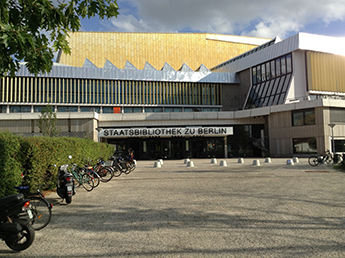
The entrance of the Berlin State Library
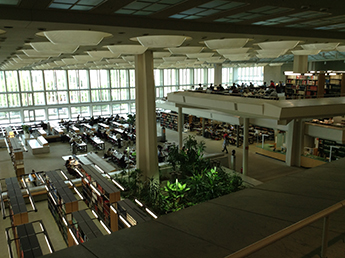
Inside the library
The Berlin State Library has exchange programs of governmental publications with the National Diet Library of Japan, the National Central Library of Taiwan, and the National Library of Korea. Among the entire collection of eleven million books and materials, the library has 700,000 items of East Asian-related materials. Most of the East Asia-related materials are in the stacks of Friedrichshagen in the suburbs of Berlin; children's books and newspapers are in Westhafen; maps and manuscripts are currently in Unter den Linden and Potsdamer Straße, but will move to Unter den Linden permanently once the renovation works there are finished. Depending on the time a request is made, it takes until the afternoon or until the next day to transfer materials to Unter den Linden or Potsdamer Straße. Users can also request books not stocked in the library with the general Inter-Library Loan services.
Apart from the main catalogue called Stabikat (http://stabikat.de/) the library also provides several other catalogues. One of them is Kalliope, the Union Catalog for searching personal papers, manuscripts, and publishers' archives.
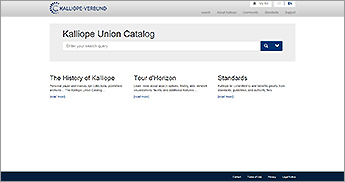
Kalliope Union Catalog
The East Asia Department (http://staatsbibliothek-berlin.de/en/about-the-library/abteilungen/ostasien/) was originally established in 1922 and is currently located in the building at Potsdamer Straße. Among the 22 staff members in the department, there are seven in charge of Japanese materials, including two Subject Specialists for Japan, nine are responsible for Chinese materials, and there are two members in charge of Korean and Central Asian materials each. The staff provides guidance and reference information services, purchases new publications, updates the catalogue (http://crossasia.stabikat.de), and receives donations of books and materials from scholars. In addition the East Asia Department is collaborating with the Jagiellonian University in Poland for the "Berlin-Krakow Project: The Digitisation of East Asian Berlinka,", a digitization project to integrate the East Asia related materials and collections of the pre-war era which were evacuated to Poland during WWII into virtual collections. This digitization projects includes among others the collection of Paul Georg von Moellendorff (1847-1901), advisor to Li Hongzhang of the Qing dynasty and King Gojong of the Joseon dynasty.
→Berlin-Krakow Project: The Digitisation of East Asian Berlinka
The current collection of premodern titles of the East Asia Department is available in open access on the website of the Berlin State Library (http://digital.staatsbibliothek-berlin.de/). Please click on "Japonica" to browse the Japanese collection including several handscrolls as well as manuscripts and printed books mainly from the Edo and Meiji period.
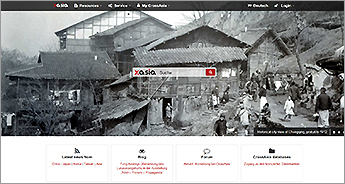
CrossAsia
Last but not least the East Asia Department is responsible for the Specialised Information Service "CrossAsia – FID Asia" in collaboration with the University Library Heidelberg and the South-Asia Institute Heidelberg. This Specialised Information Service provides many databases, ejournals and ebooks from and related to Asia to registered users, mainly students and scholars of Asian studies, in Germany via the portal site CrossAsia.
Books refering to JACAR or documents from its database donated in current year are as follows.
|
Author or Editor
|
Title
|
Publisher
|
Year
|
|
潘洵・著,徐勇・監修,波多野澄雄・監修,柳英武・訳
|
重慶大爆撃の研究
|
岩波書店
|
2016
|
|
宮下雄一郎・著
|
フランス再興と国際秩序の構想 第二次世界大戦期の政治と外交
|
勁草書房
|
2016
|
|
部落解放・人権研究所衡平社史料研究会・編,金仲燮・監修,水野直樹・監修
|
朝鮮衡平運動史料集
|
解放出版社
|
2016
|
|
関誠・著
|
日清開戦前夜における日本のインテリジェンス 明治前期の軍事情報活動と外交政策
|
ミネルヴァ書房
|
2016
|
|
東京大学平賀譲研究会・編,呉市海事歴史科学館(大和ミュージアム)・編
|
平賀譲 名軍艦デザイナーの足跡をたどる
|
文藝春秋
|
2008
|
|
滋賀県県政史料室・編
|
公文書でたどる近代滋賀のあゆみ(淡海文庫 52)
|
サンライズ出版
|
2013
|
|
黄自進・主編
|
國共關係與中日戰爭(中央研究院近代史研究所蒋介石研究群専書)
|
稻郷出版社
|
2016
|
|
相原佳之,尾形洋一,平野健一郎・編
|
東洋文庫蔵汪精衛政権駐日大使館文書目録
|
東洋文庫
|
2016
|
|
古結諒子・著
|
日清戦争における日本外交 東アジアをめぐる国際関係の変容
|
名古屋大学出版会
|
2016
|
|
廣部泉・著
|
人種戦争という寓話 黄禍論とアジア主義
|
名古屋大学出版会
|
2017
|
|
Period
|
Event
|
Note
|
Link
|
|
February 21 to March 19, 2017
|
Special Exhibition at the Fukuoka Communal Archives "The Exhibition of the Holdings of the National Archives of Japan: The History of Modern Japan and Fukuoka Rediscovered by the Public Records"
|
Since 2012 the National Archives of Japan has been offering exhibitions at regional archives to display part of the holdings outside of Tokyo.
This year, the holdings come to Fukuoka for an exhibition at the Fukuoka Communal Archives.
This exhibition features some familiar materials in textbook such as "the Constitution of the Empire of Japan," "the Imperial Rescript Ending the War," and "the Constitution of Japan" (their replicas on display), and "A Petition for Establishing a Popularly-Elected Chamber" and "the National Income Doubling Plan."
Other items include "the War Damage Maps" to illustrate air bombing damages of 8 cities in Fukuoka prefecture and records about "the Great Municipal Mergers of the Showa Era."
This exhibition displays valuable materials about the history of Japan and Fukuoka from the Meiji era to the postwar Showa period, together with the holdings of the Fukuoka Communal Archives.
|
|
|
April 8 to May 7, 2017
|
Special Exhibition "The Birth of the Constitution of Japan"
|
In the spring of 2017, the special exhibition features the process of drafting the Constitution of Japan in commemoration of the 70th anniversary of its enforcement.
Particularly, it focuses on Tokujiro Kanamori who substantially served as "the Constitution Minister" and played important roles of the birth of the Constitution.
It displays the process of how the Constitution of Japan had been drafted and formulated with the holdings of the National Archives of Japan.
It also exhibits the original of the Constitution of Japan during the period of the special exhibition.
|
|
|
Period
|
Event
|
Note
|
Link
|
|
January 10 to March 31, 2017
|
Featured Exhibition: "Exhibition of Sovereign Letters and Personal Letters from Heads of State: Europe (2)"
|
These sovereign letters and personal letters are communications between heads of state with signatures on them.
The Diplomatic Archives has some 1,100 letters from various heads of state to Tokugawa shoguns and Meiji, Taisho and Showa Emperors.
Among these documents, this exhibition presents major sovereign letters and personal letters sent from heads of state of Europe, which are dated between early Meiji to the prewar period of Showa.
|
|
[Postscript]
Thank you for reading JACAR Newsletter No.22.
We hope this issue includes some useful information in our reports of "Information on Related Document Holdings" of Kansai and Europe.
We would deeply appreciate any comments or feedback on our newsletter for forthcoming issues. Please send your opinions or ideas from * THIS FORM *.
Please email us if you would be interested in a member of JACAR presenting at your organization about our institution and its resources. We go to schools, research conferences, and a range of other institutions.
Leaflets about JACAR are available in English, Japanese, Chinese, and Korean, so if you would like copies, please contact us.
An email about the JACAR Newsletter has been sent to everyone who requested a copy as well as those who have exchanged business cards with JACAR staff members. If you do not wish to receive future e-mails, please let us know.
[Reference] TEL : +81-(0)3-5805-8801 E-MAIL : jacar_enquire@archives.go.jp

![* Click to Enlarge [Image 2] Title: 13. Seattle Chamber of Commerce (7th image)](img/022_content01_02_01.jpg)
![* Click to Enlarge [Image 4] Title: 12.](img/022_content01_04_01.jpg)
![* Click to Enlarge [Image 5-2] Title: 6. Seattle (3rd image)](img/022_content01_05_02.jpg)
![* Click to Enlarge [Image 5-1] Title: 6. Seattle (2nd image)](img/022_content01_05_01.jpg)
![* Click to Enlarge [Image 6] Title: 25. About the Upgrade of the Consulate in Seattle (2nd image)](img/022_content01_06_01.jpg)


